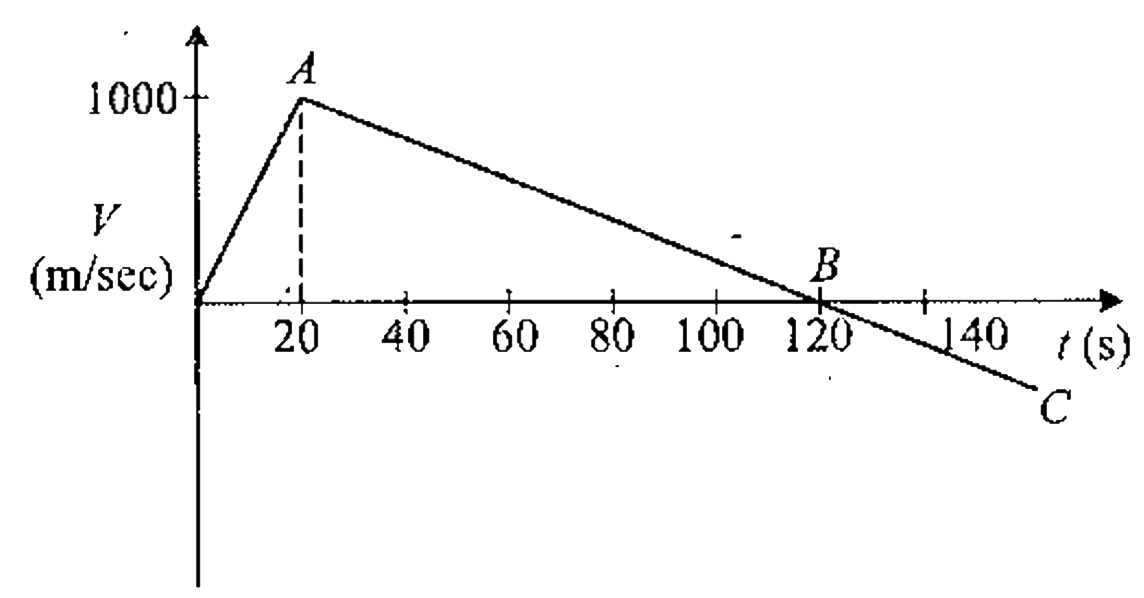A big Diwali rocket is projected vertically upward so as to attain a maximum height of 160 m. The rocket explodes just as it reaches the top of its trajectory sending out luminous particles in all possible directions all with same speed v. The display, consisting of the luminous particles, spreads out as an expanding, brilliant sphere. The bottom of this sphere just touches the ground when its radius is 80 m. With what speed (inm/s)are the luminous particles ejected by the explosion?
The correct Answer is:2
To solve the problem, we need to determine the speed at which the luminous particles are ejected when the rocket explodes at its maximum height of 160 m. The bottom of the expanding sphere of luminous particles touches the ground when its radius is 80 m.
1. Understanding the Problem:
- The rocket reaches a maximum height of 160 m before exploding.
- The luminous particles spread out in all directions and form a sphere with a radius of 80 m when it touches the ground.
2. Setting Up the Scenario:
- Let the speed of the ejected particles be v.
- The time taken for the particles to reach the ground from the maximum height can be calculated using the equations of motion.
3. Using the Equation of Motion:
- The distance fallen by the particles from the maximum height to the ground is 160 m.
- The equation of motion for an object falling under gravity is given by:
d=v0t+12gt2
- Here, d=160m (the height from which they fall), v0=0 (initial velocity at the top), and g=9.8m/s2.
4. Calculating the Time of Fall:
- Plugging in the values, we have:
160=0⋅t+12⋅9.8⋅t2
- Simplifying gives:
160=4.9t2
- Rearranging for t2:
t2=1604.9≈32.65
- Taking the square root:
t≈5.7s
5. Finding the Radius of the Sphere:
- The radius of the sphere is given as 80 m. The particles are ejected with a speed v and travel for a time t before reaching the ground.
- The distance traveled by the particles in the horizontal direction (which is the radius of the sphere) is given by:
r=v⋅t
- Substituting for r:
80=v⋅5.7
6. Solving for Speed v:
- Rearranging the equation gives:
v=805.7≈14.04m/s
Final Answer:
The speed at which the luminous particles are ejected by the explosion is approximately 14.04 m/s.
- The rocket reaches a maximum height of 160 m before exploding.
- The luminous particles spread out in all directions and form a sphere with a radius of 80 m when it touches the ground.
- Let the speed of the ejected particles be v.
- The time taken for the particles to reach the ground from the maximum height can be calculated using the equations of motion.
- The distance fallen by the particles from the maximum height to the ground is 160 m.
- The equation of motion for an object falling under gravity is given by:
d=v0t+12gt2
- Here, d=160m (the height from which they fall), v0=0 (initial velocity at the top), and g=9.8m/s2.
- Plugging in the values, we have:
160=0⋅t+12⋅9.8⋅t2
- Simplifying gives:
160=4.9t2
- Rearranging for t2:
t2=1604.9≈32.65
- Taking the square root:
t≈5.7s
- The radius of the sphere is given as 80 m. The particles are ejected with a speed v and travel for a time t before reaching the ground.
- The distance traveled by the particles in the horizontal direction (which is the radius of the sphere) is given by:
r=v⋅t
- Substituting for r:
80=v⋅5.7
- Rearranging the equation gives:
v=805.7≈14.04m/s
The speed at which the luminous particles are ejected by the explosion is approximately 14.04 m/s.
Topper's Solved these Questions
- MISCELLANEOUS KINEMATICSBOOK - CENGAGE PHYSICS ENGLISHCHAPTER - MISCELLANEOUS KINEMATICSEXERCISE - Fill in the blanks
4 Videos
- MISCELLANEOUS KINEMATICSBOOK - CENGAGE PHYSICS ENGLISHCHAPTER - MISCELLANEOUS KINEMATICSEXERCISE - True or False
2 Videos
- MISCELLANEOUS KINEMATICSBOOK - CENGAGE PHYSICS ENGLISHCHAPTER - MISCELLANEOUS KINEMATICSEXERCISE - Linked Comprehension Type
35 Videos
- LINEAR AND ANGULAR SIMPLE HARMONIC MOTIONBOOK - CENGAGE PHYSICS ENGLISHCHAPTER - LINEAR AND ANGULAR SIMPLE HARMONIC MOTIONEXERCISE - Single correct anwer type
14 Videos
- MISCELLANEOUS VOLUME 2BOOK - CENGAGE PHYSICS ENGLISHCHAPTER - MISCELLANEOUS VOLUME 2EXERCISE - INTEGER_TYPE
10 Videos
Similar Questions
Knowledge Check
A particle is projected vertically upwards and it reaches the maximum height H in time T seconds. The height of the particle at any time t will be-
Ag(t−T)2BH−12g(t−T)2C12g(t−T)2DH−g(t−T)2
A stone projected vertically upwards from the ground reaches a maximum height h. When it is at a height (3h)/(4), the ratio of its kinetic and potential energies is
View SolutionA particle is projected vertically upwards from ground with velocity 10 m/s. Find the time taken by it to reach at the highest point ?
View SolutionA stone is projected vertically upward to reach maximum height h. The ratio of its kinetic energy to its potential energy at a height 45h, will be
View SolutionA body is thrown vertically upwards from the ground. It reaches a maximum height of 20m in 5s. After what time it will reach the ground from its maximum height position ?
View SolutionA rocket is projected vertically upwards and its time velocity graph is shown in the figure-1.115. The maximum height attained by the rocket is :

View SolutionA particle is projected vertically upwards. Prove that it will be at three-fourth of its greatest height at times which are in the ratio 1:3.
View SolutionWhen a particle is thrown vertically upwards, its velocity at one third of its maximum height is 10√2m/s. The maximum height attained by it is
View Solution
